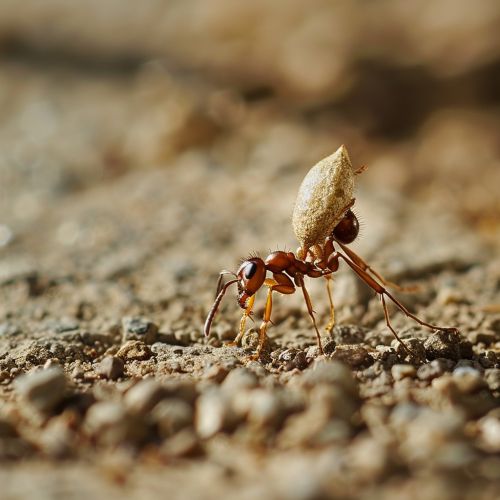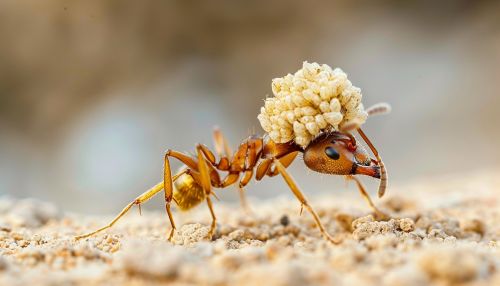Myrmecochory
Introduction
Myrmecochory is a form of seed dispersal facilitated by ants. This mutualistic interaction is a significant ecological process that influences plant community dynamics, seedling recruitment, and the spatial distribution of plant species. Myrmecochory is particularly prevalent in temperate and tropical ecosystems, where it plays a crucial role in maintaining biodiversity and ecosystem function.
Mechanisms of Myrmecochory
Myrmecochory involves the transport of seeds by ants, which are attracted to a nutrient-rich appendage called an elaiosome. The elaiosome is a lipid-rich structure that provides a food reward for the ants. When ants collect seeds with elaiosomes, they transport them back to their nests, consume the elaiosomes, and discard the seeds in nutrient-rich refuse piles, which are favorable sites for germination.
Seed Characteristics
Seeds dispersed by ants typically possess specific traits that facilitate myrmecochory. These traits include:
- Presence of an elaiosome
- Small to medium seed size
- Hard seed coat to withstand handling by ants
The elaiosome's chemical composition, including lipids, proteins, and carbohydrates, is crucial in attracting ants. The size and shape of the elaiosome can also influence the likelihood of seed dispersal.
Ant Behavior
Ants exhibit specific behaviors that enhance seed dispersal. These behaviors include:
- Foraging for elaiosome-bearing seeds
- Transporting seeds back to the nest
- Consuming the elaiosome and discarding the seed
Different ant species may exhibit varying degrees of efficiency in seed dispersal, influenced by their foraging range, nest structure, and dietary preferences.
Ecological Significance
Myrmecochory has profound ecological implications for plant communities. It affects seedling establishment, plant population dynamics, and community structure.
Seedling Establishment
Seeds dispersed by ants benefit from being deposited in nutrient-rich environments, such as ant refuse piles. These sites provide favorable conditions for germination and seedling growth, including higher nutrient availability and protection from seed predators.
Plant Population Dynamics
Myrmecochory influences plant population dynamics by affecting seed dispersal distances and patterns. Ants can transport seeds over considerable distances, leading to increased genetic diversity and reduced competition among seedlings. This dispersal mechanism also allows plants to colonize new areas and maintain population connectivity.
Community Structure
The presence of myrmecochorous plants can shape the structure of plant communities. By facilitating the dispersal of specific plant species, ants contribute to the spatial distribution and abundance of these plants. This interaction can influence plant diversity and the composition of plant communities.
Evolutionary Aspects
The evolution of myrmecochory involves complex interactions between plants and ants. Coevolutionary processes have led to the development of specialized traits in both plants and ants that enhance the mutualistic relationship.
Plant Adaptations
Plants have evolved various adaptations to attract ants and facilitate seed dispersal. These adaptations include:
- Development of elaiosomes with specific chemical compositions
- Timing of seed release to coincide with ant foraging activity
- Structural modifications to seeds that enhance transportability
Ant Adaptations
Ants have also evolved traits that enhance their role as seed dispersers. These traits include:
- Foraging behaviors that target elaiosome-bearing seeds
- Nest structures that provide suitable environments for seed germination
- Dietary preferences that include elaiosomes
Geographic Distribution
Myrmecochory is widespread across various biomes, with notable occurrences in temperate forests, tropical rainforests, and Mediterranean ecosystems. The prevalence of myrmecochory in these regions is influenced by factors such as ant diversity, plant species richness, and environmental conditions.
Temperate Forests
In temperate forests, myrmecochory is a common dispersal mechanism for understory plants. Species such as Trillium and Hepatica rely on ants for seed dispersal. The seasonal activity of ants in these forests aligns with the timing of seed release, enhancing the effectiveness of myrmecochory.
Tropical Rainforests
Tropical rainforests host a diverse array of myrmecochorous plants and ant species. The high biodiversity and complex ecological interactions in these ecosystems create a conducive environment for myrmecochory. Notable examples include plants in the Myrtaceae and Rubiaceae families.
Mediterranean Ecosystems
Myrmecochory is also prevalent in Mediterranean ecosystems, where it plays a crucial role in the dispersal of many shrub and herbaceous species. The adaptation of plants to the dry, nutrient-poor soils of these regions often involves reliance on ants for seed dispersal.
Case Studies
Several case studies highlight the importance of myrmecochory in different ecosystems.
Australian Sclerophyll Forests
In Australian sclerophyll forests, myrmecochory is a key dispersal mechanism for many plant species, including members of the Proteaceae family. The interaction between ants and these plants has been extensively studied, revealing insights into the coevolutionary processes driving myrmecochory.
North American Deciduous Forests
In North American deciduous forests, myrmecochory is crucial for the dispersal of spring ephemerals such as Sanguinaria canadensis and Asarum canadense. These plants rely on ants to transport their seeds to nutrient-rich microsites, enhancing seedling establishment and survival.
South African Fynbos
The fynbos biome of South Africa is characterized by high plant diversity and a significant reliance on myrmecochory. Many fynbos species, including those in the Ericaceae and Restionaceae families, have evolved specialized traits to attract ants and facilitate seed dispersal.
Conservation Implications
Understanding myrmecochory has important implications for conservation efforts. The disruption of ant-plant interactions due to habitat loss, climate change, and invasive species can negatively impact seed dispersal and plant community dynamics.
Habitat Loss
Habitat loss and fragmentation can disrupt the mutualistic relationship between ants and plants. The decline in ant populations due to habitat destruction can lead to reduced seed dispersal and lower plant recruitment rates. Conservation strategies should focus on preserving habitats that support both myrmecochorous plants and their ant dispersers.
Climate Change
Climate change can alter the phenology of both ants and plants, potentially disrupting the timing of seed dispersal. Changes in temperature and precipitation patterns can affect ant foraging behavior and plant reproductive cycles. Understanding these impacts is crucial for predicting and mitigating the effects of climate change on myrmecochory.
Invasive Species
Invasive species, both plants and ants, can disrupt native myrmecochory interactions. Invasive ants may outcompete native ant species, reducing the effectiveness of seed dispersal. Similarly, invasive plants may alter the availability of elaiosome-bearing seeds, impacting ant foraging behavior. Managing invasive species is essential for maintaining the integrity of myrmecochory interactions.
Future Research Directions
Future research on myrmecochory should focus on understanding the complex interactions between ants and plants, the ecological and evolutionary drivers of this mutualism, and the impacts of environmental changes on seed dispersal dynamics.
Molecular Ecology
Advances in molecular ecology techniques can provide insights into the genetic basis of myrmecochory. Studies on the genetic diversity of myrmecochorous plants and their associated ant species can reveal patterns of coevolution and adaptation.
Climate Change Impacts
Research on the effects of climate change on myrmecochory is critical for predicting future changes in seed dispersal dynamics. Long-term studies on the phenology of ants and plants, as well as experimental manipulations of temperature and precipitation, can help elucidate the potential impacts of climate change.
Conservation Strategies
Developing effective conservation strategies requires a thorough understanding of myrmecochory and its ecological significance. Research on habitat restoration, invasive species management, and the preservation of ant-plant interactions can inform conservation efforts aimed at maintaining biodiversity and ecosystem function.
See Also
References


